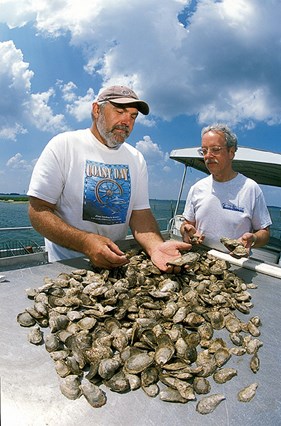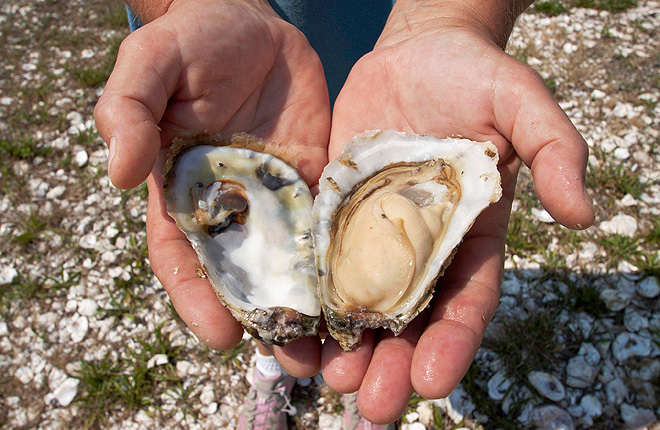ARS Research Helps Make Oysters Safer
Farmed oysters and clams are the leading species when it comes to U.S. marine aquaculture, with sales of all mollusks at nearly $329 million. They are a delicious, nutritious, and often gourmet addition to people’s diets.
Furthermore, these shellfish are critical to brackish and saltwater ecosystems as they filter and purify seawater. They are also an essential economic engine for communities all along U.S. coasts, fostering tourism, promoting the restaurant trade, and supporting commercial waterfront industries.
On the downside, eating raw or undercooked shellfish, particularly oysters, is the leading cause of outbreaks of shellfish-borne bacterial illness each year. Annually, about 80,000 cases of vibriosis in the United States are due to the bacterium Vibrio parahaemolyticus, according to the Centers for Disease Control and Prevention. A different species, V. vulnificus, is the primary cause of shellfish-related mortality and may cause about 100 deaths a year.
Two other Vibrio species have been devastating oyster and clam hatchery operations, destroying billions of larval shellfish, which are essential to sustaining the commercial shellfish industry. Vibrio-associated losses of 80 to 100 percent of a hatchery generation are not uncommon. East coast hatcheries have been hardest hit by V. tubiashii. West coast and Hawaiian hatcheries have found a different species to be a problem: V. coralliilyticus. This bacterium is more widely known as the cause of coral bleaching, triggering the demise of tropical and subtropical reefs worldwide.
Without effective controls against these vibrios, the molluscan shellfish industry could be lost for future generations, especially on the west coast, where these pathogens appear to infect not only hatchery stocks of larval shellfish, but native stocks as well.
ARS to the Rescue
Agricultural Research Service (ARS) microbiologist Gary Richards and technician Michael Watson with the Food Safety and Intervention Technologies Research Unit in Dover, Delaware, have an idea that could fix both the hatchery and the seafood safety issues.
 ARS microbiologist Gary Richards (right) and University of Delaware scientist John Ewart examine freshly harvested oysters before transport to the laboratory. (Stephen Ausmus, K11763-1) |
“We are channeling the ancient proverb ‘the enemy of my enemy is my friend’ by enlisting natural enemies of Vibrio bacteria called bacteriophages as potential control agents,” explains Richards.
Bacteriophages, or phages for short, are bacterial viruses that each target very specific species of bacteria, infecting and killing them. They are the most numerous type of life form on Earth. For example, humans have 10 trillion or so bacteria in their gastrointestinal tracts—and more than 10 times that number of phages. The trick was to find specific phages that readily kill problematic Vibrio species.
Richards first found phages effective against these vibrios in the deep waters around Hawaii. He is still hunting for more phage strains effective against V. tubiashii, the more common culprit on the east coast.
“With the strains we have already tested, we have been able to reduce losses in a small-scale research hatchery by 80 percent of what it was without the phages,” Richards says. “The problem is that vibrios can develop resistance to a single phage strain very quickly, so we are looking for a mixture of different phage strains to prevent resistance.”
ARS has already signed a three-way cooperative research and development agreement with Baltimore-based biotechnology company Intralytix, Inc., to commercialize a phage-based treatment product for use in shellfish hatcheries and with Oregon State University to further evaluate this product in its research hatchery.
Once the phage treatment is accepted for hatchery use by regulatory agencies and the industry, it should not be hard to make the jump to a phage “cocktail” that can target and reduce or eliminate human pathogenic vibrios from market-sized oysters. This would relieve many of the shellfish safety concerns for consumers and the industry.
As powerful as they are against vibrios, these phages are harmless to animals and plants. That makes them desirable weapons for use in aquaculture and food processing, Richards explains.
Phages meet another crucial test for use on oysters: “They don’t affect the taste, smell, consistency, or freshness of oysters,” Richards says. “Nor do they hurt or kill the oysters. But they can potentially kill most or all of the disease-causing Vibrio bacteria the oyster might harbor, making raw or lightly cooked oysters on the half shell safer to eat,”
Consumers are becoming increasingly conscious of food safety concerns with shellfish. A safe, nonantibiotic answer to a major problem facing aquaculture and seafood safety could be very welcome.
Finding Another Enemy
Phages are not the only enemy of vibrios that Richards and Watson are enlisting in the fight for aquaculture food safety.
“We found that in the coastal waters off of Delaware, Alabama, and Hawaii, there are a number of naturally occurring Vibrio predatory bacteria (VPB),” says Richards. He and his colleagues have isolated and characterized two groups of VPB with biocontrol potential: Pseudoalteromonas piscicida and a species of Halobacteriovorax. In the lab, these two have been shown to specifically and dramatically reduce human pathogenic vibrios in seawater.
Richards’s idea is to take advantage of VPB’s abilities to serve as Vibrio predators in seawater by introducing the bacteria into a shellfish industry process known as depuration. During depuration, market-sized shellfish are held in large tanks of clean, recirculating seawater that is continuously disinfected by UV light or other means. This allows the shellfish to expel many types of contaminating bacteria. But vibrios, which are native to the marine environment, are not readily purged during standard depuration.
Pretreatment with VPB, phages, or both may allow shellfish to pick up these beneficial bacteria or viruses during the normal commercial filtering processes where they could disinfect vibrios from within the edible shellfish tissues, according to Richards.
There is a lot of interest in the possibilities that VPBs offer.
Currently, research collaborators in Italy and domestically are evaluating VPBs to eliminate vibrios in mussels, as well as E. coli and Salmonella on the surface of tomatoes, lettuce, and other produce.
“New ‘green’ technologies like these for fighting pathogens in foods are the wave of the future and may reduce the need for antibiotic use and the inadvertent development of antibiotic-resistant pathogens,” Richards says.—By J. Kim Kaplan, ARS Office of Communications.
Key Facts
- Shellfish are the top producers in U.S. marine aquaculture with a farmgate value of about $329 million.
- Two Vibrio species cause most of the shellfish-borne bacterial human illness.
- Two other Vibrio species kill billions of oyster larvae each year in hatcheries.
- ARS scientists are studying vibrios’ natural enemies as controls.
Full Story







